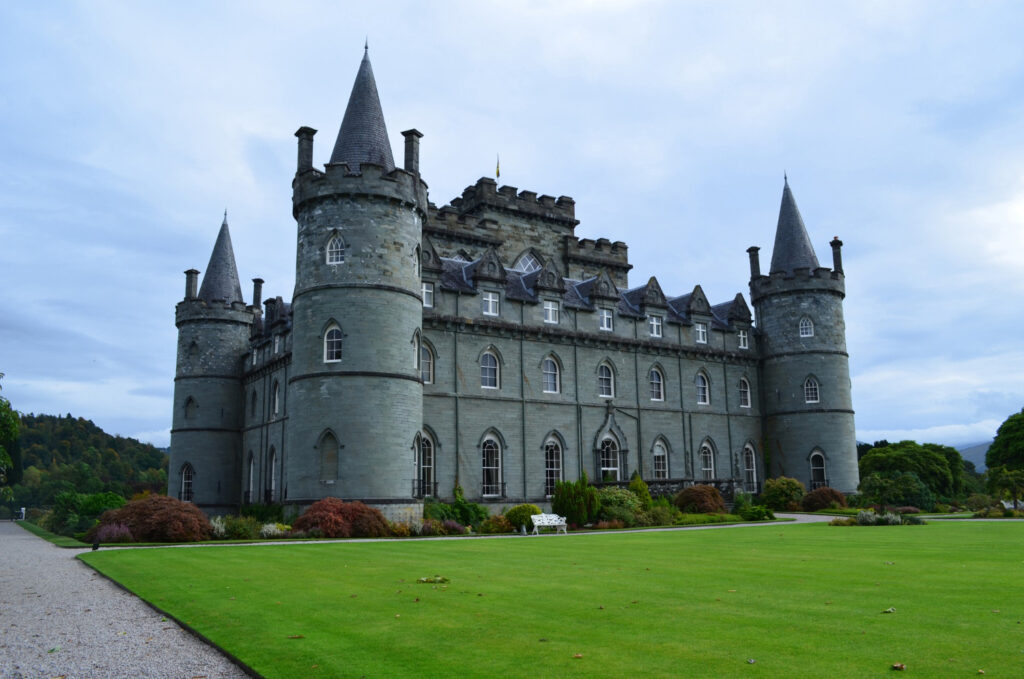When people think of castles, their minds often wander to the rolling hills of Wales, the rugged landscapes of Scotland, or the countryside of France and England. Yet tucked away in Middle Tennessee, just outside Nashville, stands an unexpected landmark that looks as if it has leapt from the pages of a medieval fairytale. This striking residence, known as Castle Gwynn, is more than a home—it is a lifelong dream brought to life by determination, creativity, and passion.
Castle Gwynn sits near the towns of Arrington and Triune, visible from State Route 840. Its white towers rise above the trees, instantly sparking curiosity from travelers who wonder why a medieval-style fortress appears in the Tennessee countryside. Built over decades by Nashville native Mike Freeman, Castle Gwynn blends authentic medieval influences with modern comforts. It has become a local treasure, a cultural landmark, and the centerpiece of the annual Tennessee Renaissance Festival.
In this article, we’ll explore the fascinating story of Castle Gwynn—from its humble beginnings as a high-school sketch to its recognition in global pop culture. You’ll learn about its architecture, life inside its walls, its role in community celebrations, and the lasting legacy it continues to build.
The Origins of Castle Gwynn
Every remarkable creation begins with a dream, and Castle Gwynn is no exception. For its builder, Mike Freeman, the idea was planted during a high school architecture assignment in the 1960s. The teacher asked students to sketch their dream home, and while most imagined suburban houses or ranch-style dwellings, Freeman envisioned something entirely different: a medieval castle.
That sketch did not remain on paper. Instead, it grew into a lifelong ambition. After graduation, Freeman pursued a career in photography, steadily building his reputation while quietly nurturing his vision of a castle in Tennessee. For him, the question was never whether it could be built, but how to make it possible. He spent nearly a decade searching for land, researching medieval design, and preparing for construction.
By 1980, he had acquired land near Arrington and Triune, and work officially began on Castle Gwynn. Progress was gradual, fueled by personal savings, bartering, and endless persistence. Freeman often said he paid for the castle as he went along—building when funds allowed, pausing when they didn’t. Over the decades, this patient process slowly transformed his teenage drawing into a striking stone reality.
Architecture and Design of Castle Gwynn
Castle Gwynn’s design reflects the spirit of a 12th-century Welsh border castle, but with creative adjustments to fit its builder’s vision. Its name, “Gwynn,” comes from the Welsh word for “white,” an appropriate title since its towers are finished in bright stucco. This detail not only enhances its striking appearance but also echoes a medieval defensive strategy—white walls made intruders easier to spot, even under moonlight.
Two towers dominate Castle Gwynn’s profile, each rising seven stories high. They are connected by a cloister featuring Indiana limestone arches, while a sweeping stone staircase inspired by the White House staircase descends dramatically at the front. The turrets are crowned with cone-shaped roofs, one weighing an astonishing twelve tons.
Inside, Freeman blended medieval inspiration with modern living. Brick arches, stained glass windows, and handmade tile floors bring authenticity, while concealed wiring, elevators, and climate control systems add 21st-century convenience. The kitchen stands out as a masterpiece, with its 60 arches crafted from 14,000 bricks and detailed tile floor that depicts a coat of arms.
The architecture is more than ornamental—it tells the story of resilience and craftsmanship. Local masons, artisans, and family friends contributed to the castle’s construction, often through barter. Freeman, for example, photographed weddings in exchange for masonry work, weaving community spirit into every wall and arch.
Life Inside Castle Gwynn
While many castles around the world now stand as museums or historic ruins, Castle Gwynn is unique because it remains a private residence. Mike Freeman and his wife, Jackie, live in the north tower, making it both a family home and a landmark admired by thousands each year.
The interiors balance medieval elegance with livability. Antique furnishings, stained glass lamps, and historical artwork line the rooms, creating a sense of stepping back in time. Freeman’s collection of medieval swords and plans to display suits of armor add to the castle’s immersive character.
Yet beneath the historic charm, modern life flows smoothly. Elevators hide behind wooden doors, laundry appliances sit discretely in stone walls, and heating systems remain invisible to visitors. From a cozy living room with a brick fireplace to the great hall used for entertaining, every space blends tradition with comfort.
Castle Gwynn is not merely an architectural showpiece; it is a lived-in dream, shaped by daily life, creativity, and the couple’s dedication to preserving both history and modernity under one roof.
Castle Gwynn and the Tennessee Renaissance Festival
Each May, Castle Gwynn transforms from a private residence into the lively backdrop of the Tennessee Renaissance Festival, a tradition that began in 1986. Originally, the Freemans hosted the festival as a way to share their creation with the public while embracing their love for medieval history and culture.
Over time, the event grew into one of Tennessee’s most beloved annual celebrations. For an entire month, the grounds come alive with jousting knights, jesters, artisans, and musicians dressed in Renaissance attire. Visitors explore vendor stalls offering handmade jewelry, costumes, and artwork, while food stands serve turkey legs, funnel cakes, and other festival favorites.
One highlight for attendees is the guided tour of Castle Gwynn itself, which allows the public a rare glimpse inside its halls. For many, the festival provides a chance to experience history, creativity, and community spirit all in one setting.
Pop Culture and Castle Gwynn’s Fame
Although Castle Gwynn was already a local landmark, it gained international recognition in 2008 when Taylor Swift filmed her music video for “Love Story” on its grounds. The video, inspired by Romeo and Juliet, introduced millions of viewers around the world to Tennessee’s unexpected castle.
Since then, Castle Gwynn has appeared in magazines, documentaries, and media stories that celebrate its uniqueness. This visibility turned the castle from a regional curiosity into a symbol of creativity and perseverance admired far beyond Tennessee. For many fans of Swift or architecture enthusiasts, visiting Castle Gwynn became a bucket-list experience.
Visiting Castle Gwynn Today
Castle Gwynn remains a private home for most of the year, but thanks to the Tennessee Renaissance Festival, visitors can experience its magic every spring. The castle is located about 25 miles southeast of Nashville, making it an easy day trip for both locals and tourists.
During festival weekends, guided tours allow guests to see parts of the interior, including the famous kitchen and great hall. Beyond the festival, the castle can be glimpsed from the highway, where its towers stand proudly against the Tennessee landscape.
For travelers exploring Middle Tennessee, Castle Gwynn adds a surprising twist to the region’s history, offering a destination that feels both timeless and imaginative.
The Legacy of Castle Gwynn
At its core, Castle Gwynn is more than stone, brick, and mortar. It is the physical representation of determination, creativity, and passion. What began as a teenager’s sketch became a decades-long pursuit of a dream, realized through persistence and hard work.
For Tennessee, Castle Gwynn has become a cultural landmark that celebrates imagination, history, and community spirit. For visitors, it represents a reminder that even the most ambitious dreams can come true with patience and perseverance. And for the Freemans, it is home—a place filled with stories, love, and a lifetime of dedication.
Conclusion
Castle Gwynn stands as a unique fusion of personal ambition and cultural heritage. Rising from the Tennessee hillsides, it captures the wonder of medieval castles while embodying the perseverance of one man’s vision. Whether experienced during the Tennessee Renaissance Festival, remembered through pop culture moments, or admired from afar, Castle Gwynn continues to inspire curiosity and admiration.
As both a family home and a public treasure, it reminds us that dreams, no matter how impossible they may seem, can indeed take shape in the real world. In the heart of Tennessee, Castle Gwynn proves that history, imagination, and community can come together to create something truly extraordinary.




